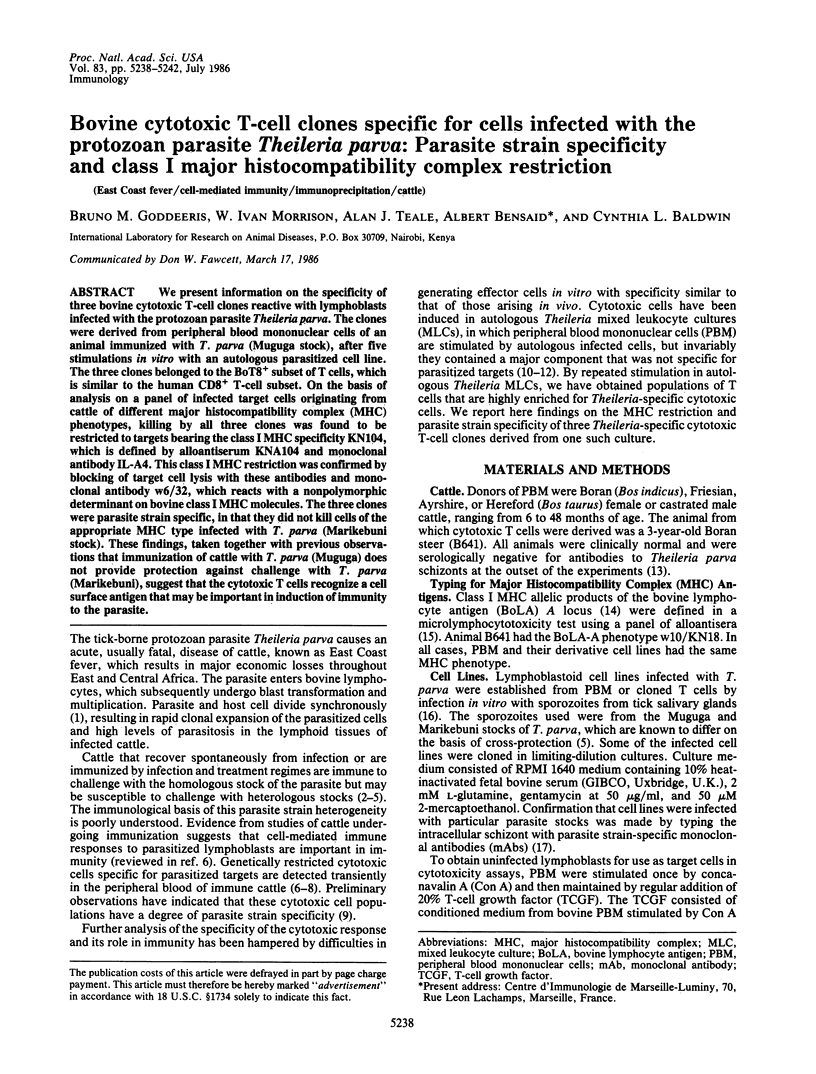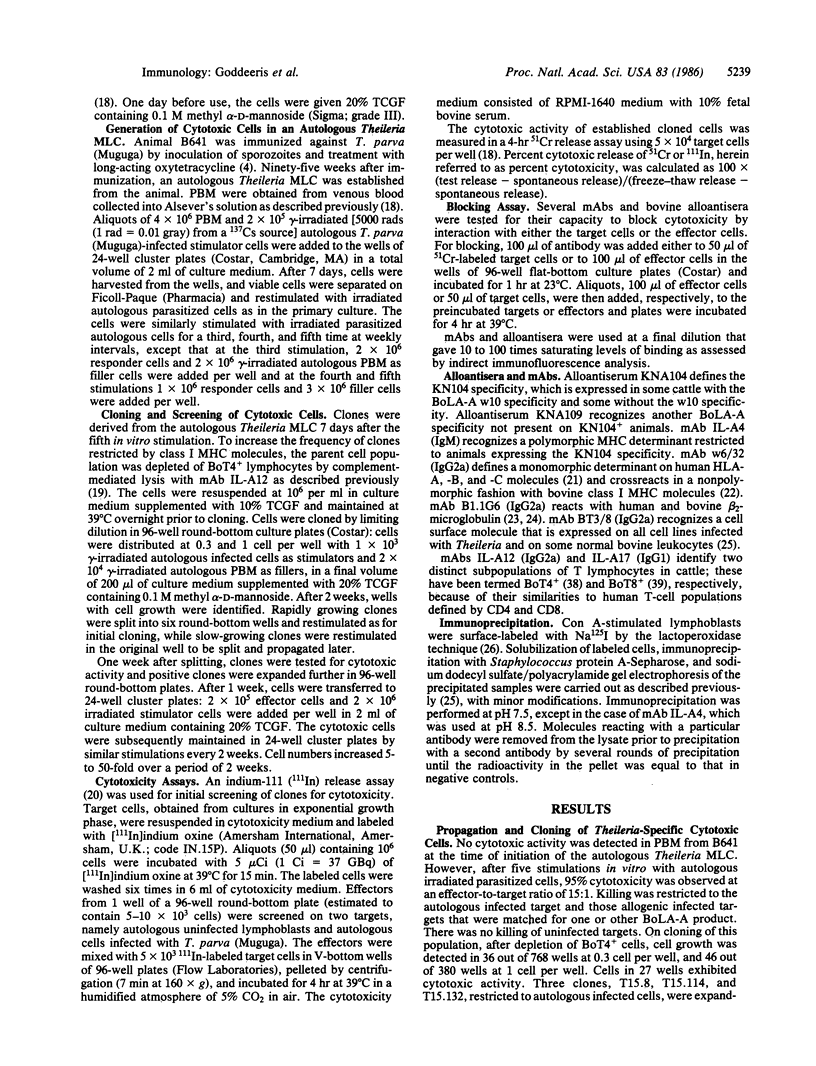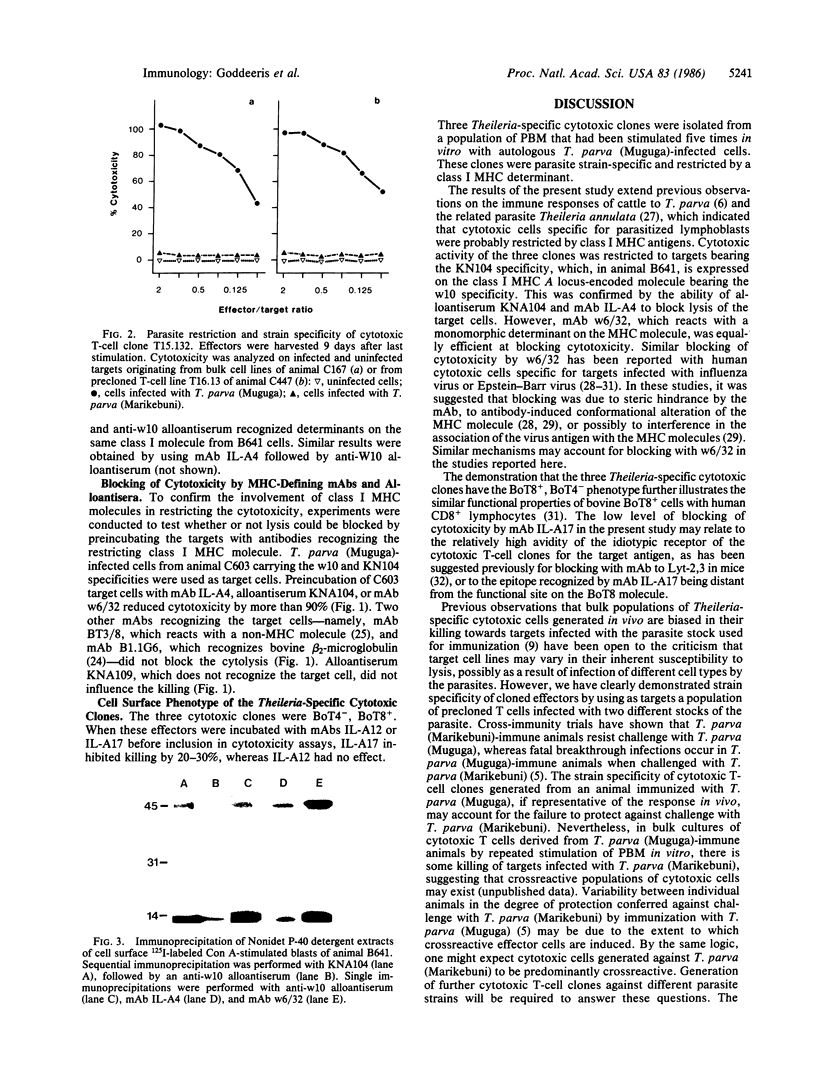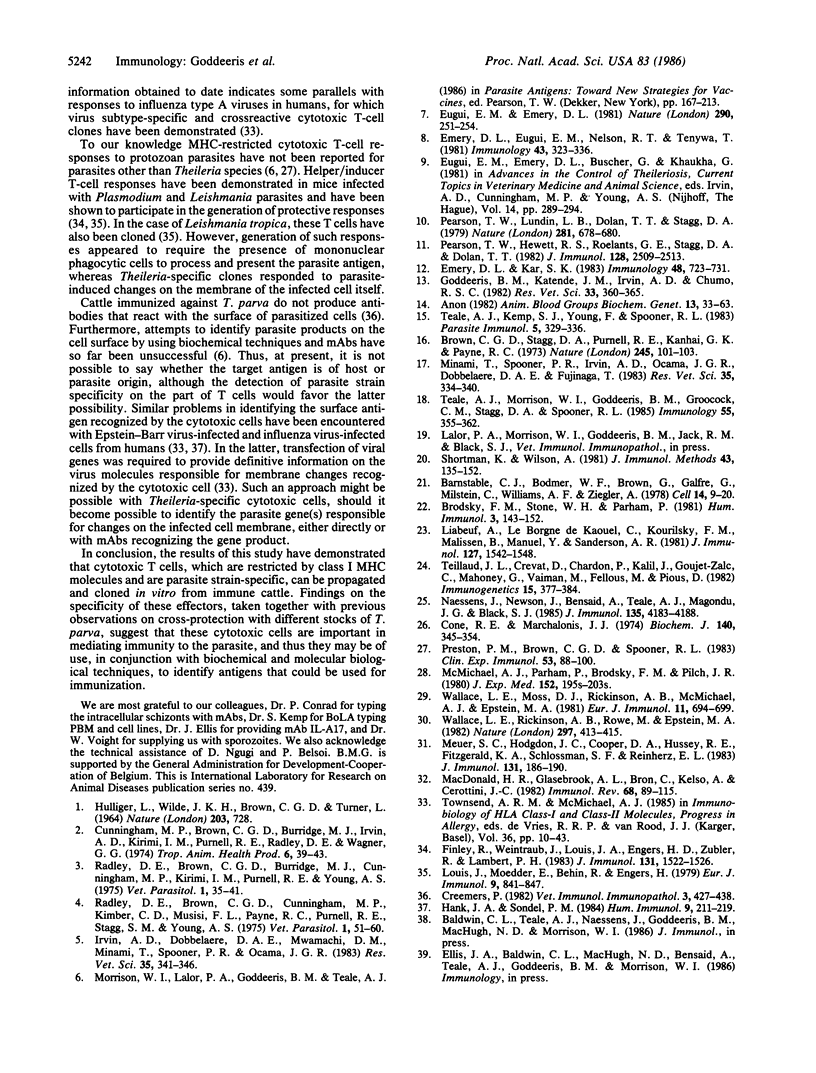Abstract
We present information on the specificity of three bovine cytotoxic T-cell clones reactive with lymphoblasts infected with the protozoan parasite Theileria parva. The clones were derived from peripheral blood mononuclear cells of an animal immunized with T. parva (Muguga stock), after five stimulations in vitro with an autologous parasitized cell line. The three clones belonged to the BoT8+ subset of T cells, which is similar to the human CD8+ T-cell subset. On the basis of analysis on a panel of infected target cells originating from cattle of different major histocompatibility complex (MHC) phenotypes, killing by all three clones was found to be restricted to targets bearing the class I MHC specificity KN104, which is defined by alloantiserum KNA104 and monoclonal antibody IL-A4. This class I MHC restriction was confirmed by blocking of target cell lysis with these antibodies and monoclonal antibody w6/32, which reacts with a nonpolymorphic determinant on bovine class I MHC molecules. The three clones were parasite strain specific, in that they did not kill cells of the appropriate MHC type infected with T. parva (Marikebuni stock). These findings, taken together with previous observations that immunization of cattle with T. parva (Muguga) does not provide protection against challenge with T. parva (Marikebuni), suggest that the cytotoxic T cells recognize a cell surface antigen that may be important in induction of immunity to the parasite.
Full text
PDF




Images in this article
Selected References
These references are in PubMed. This may not be the complete list of references from this article.
- Barnstable C. J., Bodmer W. F., Brown G., Galfre G., Milstein C., Williams A. F., Ziegler A. Production of monoclonal antibodies to group A erythrocytes, HLA and other human cell surface antigens-new tools for genetic analysis. Cell. 1978 May;14(1):9–20. doi: 10.1016/0092-8674(78)90296-9. [DOI] [PubMed] [Google Scholar]
- Brodsky F. M., Stone W. H., Parham P. Of cows and men: a comparative study of histocompatibility antigens. Hum Immunol. 1981 Oct;3(2):143–152. doi: 10.1016/0198-8859(81)90051-3. [DOI] [PubMed] [Google Scholar]
- Brown C. G., Stagg D. A., Purnell R. E., Kanhai G. K., Payne R. C. Letter: Infection and transformation of bovine lymphoid cells in vitro by infective particles of Theileria parva. Nature. 1973 Sep 14;245(5420):101–103. doi: 10.1038/245101a0. [DOI] [PubMed] [Google Scholar]
- Cone R. E., Marchalonis J. J. Surface proteins of thymus-derived lymphocytes and bone-marrow-derived lymphocytes. Selective isolation of immunoglobulin and the theta-antigen by non-ionic detergents. Biochem J. 1974 Jun;140(3):345–354. doi: 10.1042/bj1400345. [DOI] [PMC free article] [PubMed] [Google Scholar]
- Creemers P. Lack of reactivity of sera from Theileria parva-infected and recovered cattle against cell membrane antigens of Theileria parva transformed cell lines. Vet Immunol Immunopathol. 1982 Jul;3(4):427–438. doi: 10.1016/0165-2427(82)90025-3. [DOI] [PubMed] [Google Scholar]
- Cunningham M. P., Brown C. G., Burridge M. J., Irvin A. D., Kirimi I. M., Purnell R. E., Radley D. E., Wagner G. G. Theileriosis: the exposure of immunized cattle in a Theileria lawrencei enzootic area. Trop Anim Health Prod. 1974 Feb;6(1):39–43. doi: 10.1007/BF02380747. [DOI] [PubMed] [Google Scholar]
- Emery D. L., Eugui E. M., Nelson R. T., Tenywa T. Cell-mediated immune responses to Theileria parva (East Coast fever) during immunization and lethal infections in cattle. Immunology. 1981 Jun;43(2):323–336. [PMC free article] [PubMed] [Google Scholar]
- Emery D. L., Kar S. K. Immune responses of cattle to Theileria parva (East Coast fever): specificity of cytotoxic cells generated in vivo and in vitro. Immunology. 1983 Apr;48(4):723–731. [PMC free article] [PubMed] [Google Scholar]
- Eugui E. M., Emery D. L. Genetically restricted cell-mediated cytotoxicity in cattle immune to Theileria parva. Nature. 1981 Mar 19;290(5803):251–254. doi: 10.1038/290251a0. [DOI] [PubMed] [Google Scholar]
- Finley R., Weintraub J., Louis J. A., Engers H. D., Zubler R., Lambert P. H. Prevention of cerebral malaria by adoptive transfer of malaria-specific cultured T cells into mice infected with Plasmodium berghei. J Immunol. 1983 Sep;131(3):1522–1526. [PubMed] [Google Scholar]
- Goddeeris B. M., Katende J. M., Irvin A. D., Chumo R. S. Indirect fluorescent antibody test for experimental and epizootiological studies on East coast fever (Theileria parva infection in cattle). Evaluation of a cell culture schizont antigen fixed and stored in suspension. Res Vet Sci. 1982 Nov;33(3):360–365. [PubMed] [Google Scholar]
- HULLIGER L., WILDE K. H., BROWN C. G., TURNER L. MODE OF MULTIPLICATION OF THEILERIA IN CULTURES OF BOVINE LYMPHOCYTIC CELLS. Nature. 1964 Aug 15;203:728–730. doi: 10.1038/203728a0. [DOI] [PubMed] [Google Scholar]
- Hank J. A., Sondel P. M. Recognition of autologous lymphoblastoid cells by cloned human T cells: inhibition of cytotoxicity by anti-HLA antibody but not by antibody to Epstein-Barr virus induced cell surface antigen. Hum Immunol. 1984 Apr;9(4):211–219. doi: 10.1016/0198-8859(84)90026-0. [DOI] [PubMed] [Google Scholar]
- Irvin A. D., Dobbelaere D. A., Mwamachi D. M., Minami T., Spooner P. R., Ocama J. G. Immunisation against East Coast fever: correlation between monoclonal antibody profiles of Theileria parva stocks and cross immunity in vivo. Res Vet Sci. 1983 Nov;35(3):341–346. [PubMed] [Google Scholar]
- Liabeuf A., le Borgne de Kaouel C., Kourilsky F. M., Malissen B., Manuel Y., Sanderson A. R. An antigenic determinant of human beta 2-microglobulin masked by the association with HLA heavy chains at the cell surface: analysis using monoclonal antibodies. J Immunol. 1981 Oct;127(4):1542–1548. [PubMed] [Google Scholar]
- Louis J., Moedder E., Behin R., Engers H. Recognition of protozoan parasite antigens by murine T lymphocytes. I. Induction of specific T lymphocyte-dependent proliferative response to Leishmania tropica. Eur J Immunol. 1979 Nov;9(11):841–847. doi: 10.1002/eji.1830091103. [DOI] [PubMed] [Google Scholar]
- MacDonald H. R., Glasebrook A. L., Bron C., Kelso A., Cerottini J. C. Clonal heterogeneity in the functional requirement for Lyt-2/3 molecules on cytolytic T lymphocytes (CTL): possible implications for the affinity of CTL antigen receptors. Immunol Rev. 1982;68:89–115. doi: 10.1111/j.1600-065x.1982.tb01061.x. [DOI] [PubMed] [Google Scholar]
- McMichael A. J., Parham P., Brodsky F. M., Pilch J. R. Influenza virus-specific cytotoxic T lymphocytes recognize HLA-molecules. Blocking by monoclonal anti-HLA antibodies. J Exp Med. 1980 Aug 1;152(2 Pt 2):195s–203s. [PubMed] [Google Scholar]
- Meuer S. C., Hodgdon J. C., Cooper D. A., Hussey R. E., Fitzgerald K. A., Schlossman S. F., Reinherz E. L. Human cytotoxic T cell clones directed at autologous virus-transformed targets: further evidence for linkage of genetic restriction to T4 and T8 surface glycoproteins. J Immunol. 1983 Jul;131(1):186–190. [PubMed] [Google Scholar]
- Minami T., Spooner P. R., Irvin A. D., Ocama J. G., Dobbelaere D. A., Fujinaga T. Characterisation of stocks of Theileria parva by monoclonal antibody profiles. Res Vet Sci. 1983 Nov;35(3):334–340. [PubMed] [Google Scholar]
- Naessens J., Newson J., Bensaid A., Teale A. J., Magondu J. G., Black S. J. De novo expression of T cell markers on Theileria parva-transformed lymphoblasts in cattle. J Immunol. 1985 Dec;135(6):4183–4188. [PubMed] [Google Scholar]
- Pearson T. W., Hewett R. S., Roelants G. E., Stagg D. A., Dolan T. T. Studies on the induction and specificity of cytotoxicity to Theileria-transformed cell lines. J Immunol. 1982 Jun;128(6):2509–2513. [PubMed] [Google Scholar]
- Pearson T. W., Lundin L. B., Dolan T. T., Stagg D. A. Cell-mediated immunity to Theileria-transformed cell lines. Nature. 1979 Oct 25;281(5733):678–680. doi: 10.1038/281678a0. [DOI] [PubMed] [Google Scholar]
- Preston P. M., Brown C. G., Spooner R. L. Cell-mediated cytotoxicity in Theileria annulata infection of cattle with evidence for BoLA restriction. Clin Exp Immunol. 1983 Jul;53(1):88–100. [PMC free article] [PubMed] [Google Scholar]
- Shortman K., Wilson A. A new assay for cytotoxic lymphocytes, based on a radioautographic readout of 111 In release, suitable for rapid, semi-automated assessment of limit-dilution cultures. J Immunol Methods. 1981;43(2):135–152. doi: 10.1016/0022-1759(81)90017-x. [DOI] [PubMed] [Google Scholar]
- Teale A. J., Kemp S. J., Young F., Spooner R. L. Selection, by major histocompatibility type (BoLA), of lymphoid cells derived from a bovine chimaera and transformed by Theileria parasites. Parasite Immunol. 1983 May;5(3):329–335. doi: 10.1111/j.1365-3024.1983.tb00748.x. [DOI] [PubMed] [Google Scholar]
- Teale A. J., Morrison W. I., Goddeeris B. M., Groocock C. M., Stagg D. A., Spooner R. L. Bovine alloreactive cytotoxic cells generated in vitro: target specificity in relation to BoLA phenotype. Immunology. 1985 Jun;55(2):355–362. [PMC free article] [PubMed] [Google Scholar]
- Teillaud J. L., Crevat D., Chardon P., Kalil J., Goujet-Zalc C., Mahouy G., Vaiman M., Fellous M., Pious D. Monoclonal antibodies as a tool for phylogenetic studies of major histocompatibility antigens and beta 2-microglobulin. Immunogenetics. 1982;15(4):377–384. doi: 10.1007/BF00364261. [DOI] [PubMed] [Google Scholar]
- Wallace L. E., Moss D. J., Rickinson A. B., McMichael A. J., Epstein M. A. Cytotoxic T cell recognition of Epstein-Barr virus-infected B cells. II. Blocking studies with monoclonal antibodies to HLA determinants. Eur J Immunol. 1981 Sep;11(9):694–699. doi: 10.1002/eji.1830110905. [DOI] [PubMed] [Google Scholar]
- Wallace L. E., Rickinson A. B., Rowe M., Epstein M. A. Epstein-Barr virus-specific cytotoxic T-cell clones restricted through a single HLA antigen. Nature. 1982 Jun 3;297(5865):413–415. doi: 10.1038/297413a0. [DOI] [PubMed] [Google Scholar]



